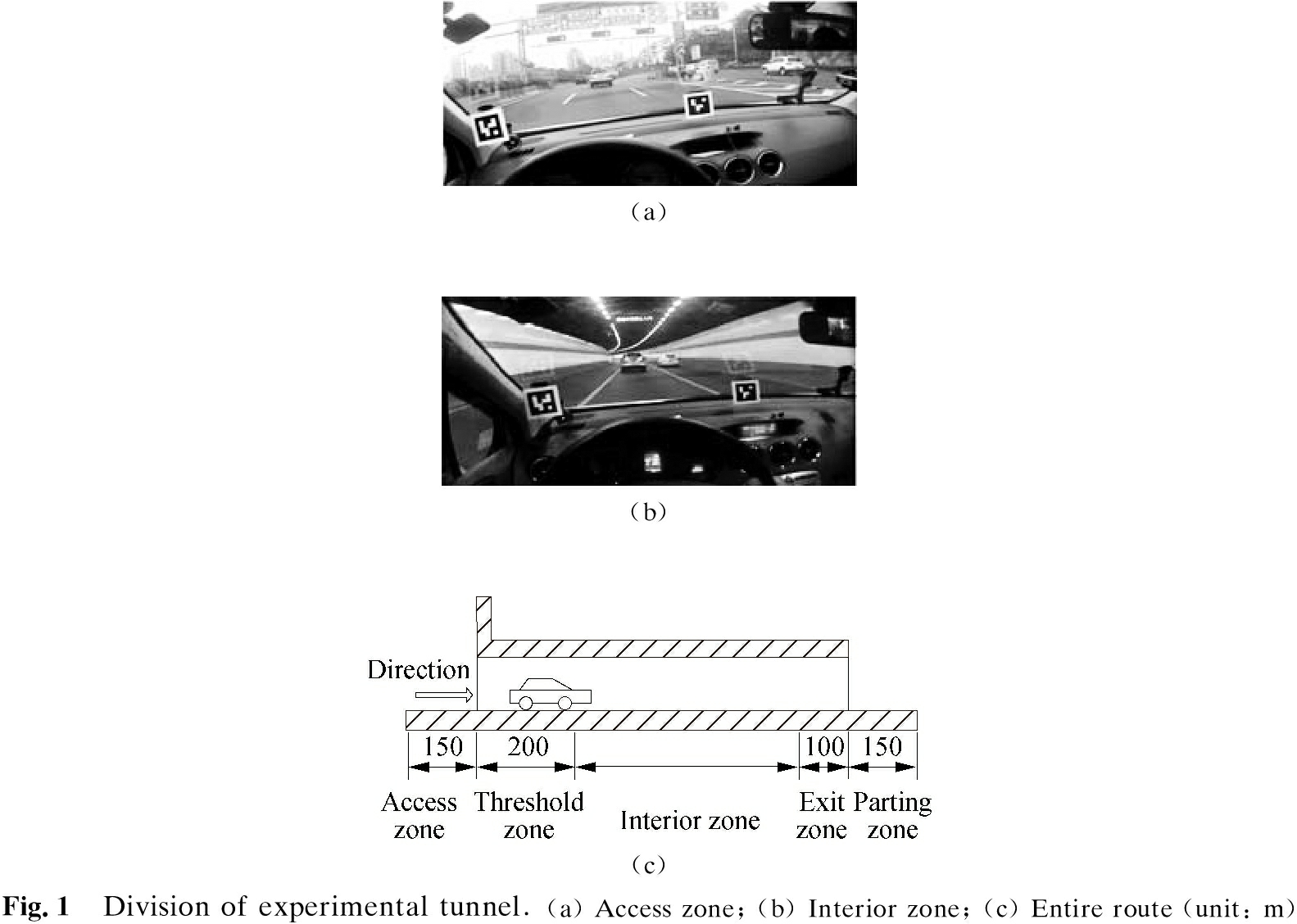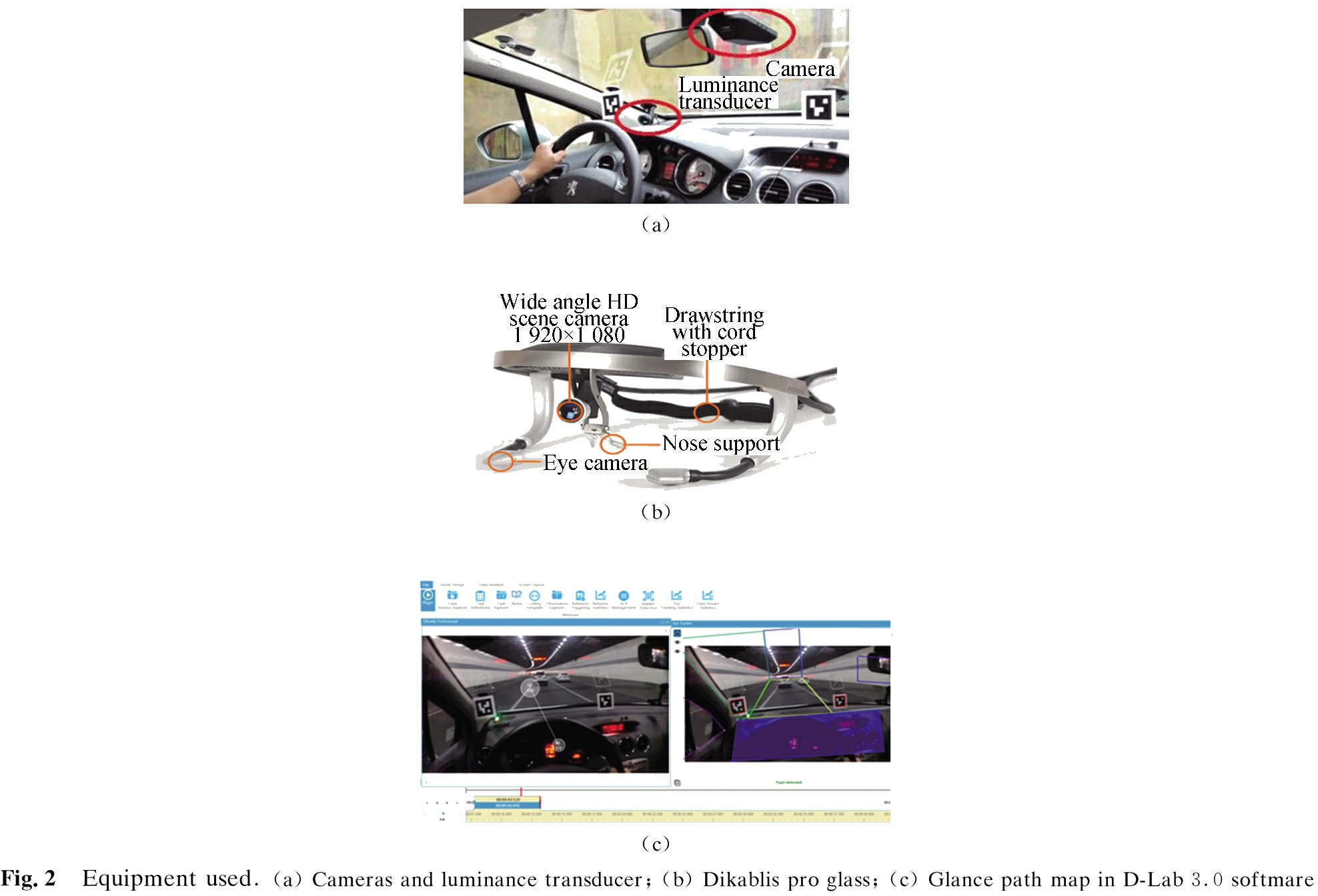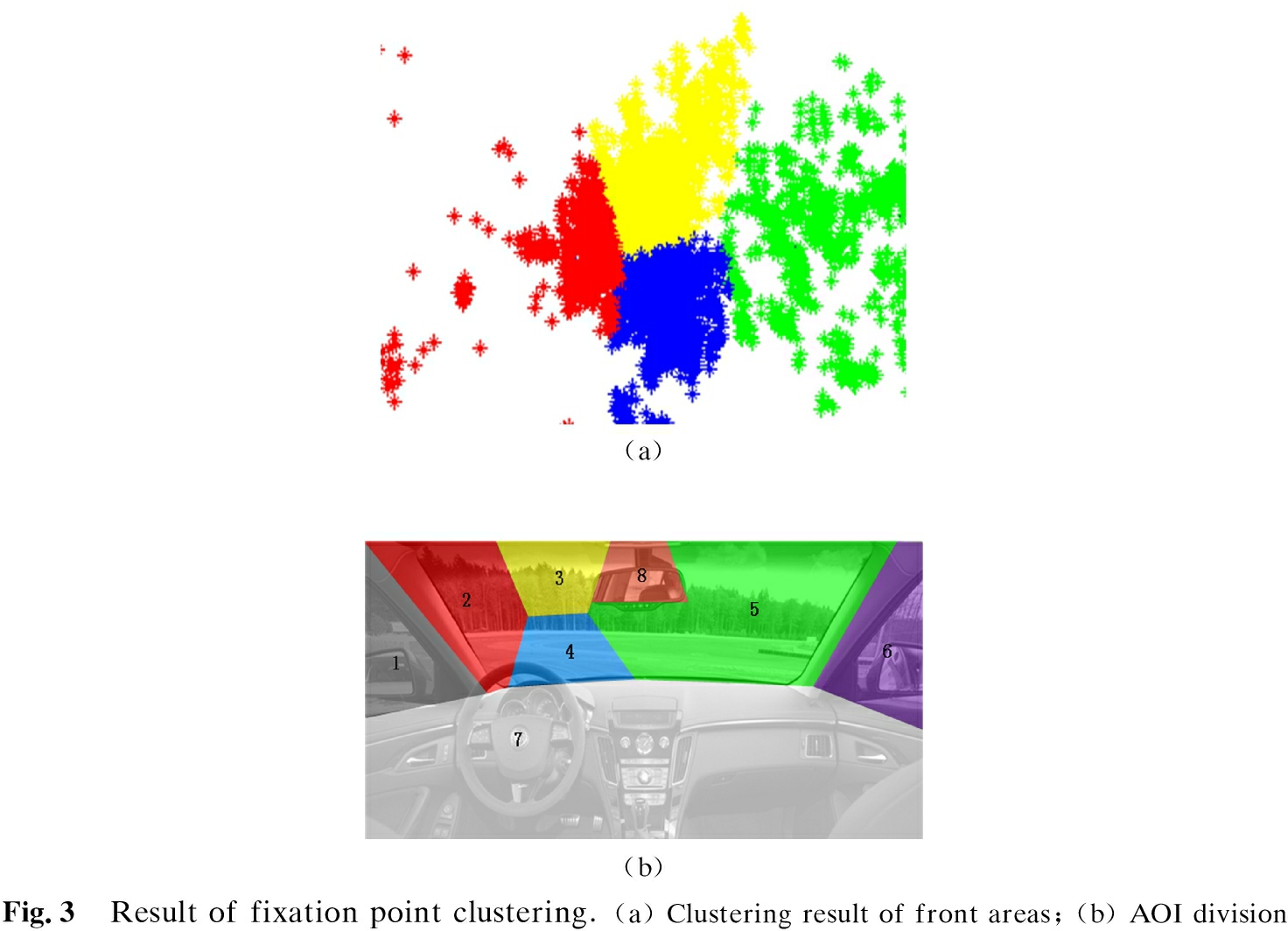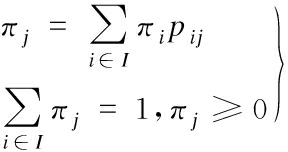Underground tunnels play an important role in three-dimensional urban traffic networks as they alleviate traffic congestion on the ground and improve traffic operation efficiency. An urban tunnel is a tubular, semi-enclosed traffic area. Although the accident rate for urban tunnels is often lower than that for open roads, the accident death rate is often higher. The main reasons are as follows: 1) greatly varied luminance inside and outside tunnels[1]; 2) closed, narrow, and long special circumstances[2]; 3) a linear shape of poor consistency[3]; and 4) driver perception of distance and speed at tunnels that differs from that on open roads[4]. Tunnel lighting is the most important objective factor, and driver perception of the tunnel environment is the most important subjective factor. Thus, drivers’ correct perception of the environment is the premise of tunnel safety. Among the total information acquired by human sensory organs, vision accounts for 80%, more than 95% of which is dynamic visual information.
Vision researchers use eye trackers to reveal the cognitive process of individuals by extracting data such as fixation point, fixation duration and sequence, saccade amplitude, and pupil area from recorded eye movement trajectories. This technology has also been gradually applied to traffic safety research. For instance, the time for observing the road in front accounts for 80% of total travel time, and the mean time for gaze shifting from the road in front to other areas is 0.65 s. Eye fixation behaviors while watching videos and while driving have also been compared. Comparison results show that fixation times for traffic signs, information, or road markings decrease as drivers become increasingly familiar with the environment. According to a study of visual adaptability, drivers need to increase eye fixation duration to perform tasks in addition to driving[5]. When drivers travel in road tunnels, their visual characteristics are affected by the tunnel environment. Visual patterns and textures on tunnel walls have been found to influence drivers’ perception of speed. Thus, accidents inside tunnels are more serious than those on open roads, and light-colored tunnel walls have been considered to be relatively safe. However, current research has mainly focused on road tunnels, and few studies have explored urban tunnels and the visual characteristics of different tunnel sections.
An increasing number of studies have found that driving experience affects eye movement behaviors. Previous research has revealed that experienced drivers’ visual search range is wider than that of novice drivers[6]. Thus, experienced drivers have better visual cognition and reaction ability than novice drivers[7]. Meanwhile, the influence of visual search patterns on risk identification has also been studied[8]. Moreover, a gaze-based integrated driving assessment approach has been proposed to study older drivers’ visual search patterns. Results show that older drivers with good executive function skills perform frequent eye fixations on curves and inside vehicle features[9].
Many mathematical models are used to predict traffic parameters,and they include Bayesian networks, neural networks, support vector machines, and Markov models[10]. However, the performance of Bayesian network models is poor because of the assumption that attributes are independent of one another. Meanwhile, neural network models have a long learning curve. Markov models are powerful finite state machines that are widely used in sequence modeling. Driver fixation transition exhibits a non-after-effect property; i.e., the probability of a fixation moving to the next point is related only to the present point. Therefore, the Markov chain model is used in the current work.
The aim of this study is to investigate the fixation transition characteristics of experienced and novice drivers in urban tunnels. The results are expected to provide insights into which elements an effective training program should feature. Section 1 describes the experiment in detail, including the test route, participants, apparatus, procedure, and data collection. Section 2 presents the K-means clustering algorithm and Markov chain theory. The former is for dividing the area of fixation interest (AOI), and the latter is for analyzing the fixation transition characteristics of drivers with different experience levels at an urban tunnel. Section 3 presents the detailed analysis results for the fixation point distributions, fixation transition probabilities, and stationary distributions. These characteristics of drivers with different driving experience levels and at different tunnel sections are compared. Section 4 concludes the study.
1 Data
1.1 Driving route determination
Shuiximen tunnel in Nanjing, China, was selected as the experimental tunnel. The length of the tunnel is 1.66 km, and the speed limit is 60 km/h. The selected tunnel is dual for a three-lane motorway with double holes. The width of each lane is 3.5 m, and the clear height in the tunnel is 4.5 m. The lighting condition is good enough to guarantee safe driving. Moreover, lane changing is prohibited in tunnels where solid lines exist. All experiments were conducted during a nonpeak hour in the daytime. In the experiment, the lighting condition was kept constant to ensure that it did not affect the participating drivers’ visual behaviors.
The tunnel was divided into the access zone, threshold zone, transition zone, interior zone, and exit zone on the basis of the illumination intensity recommended by tunnel lighting standards. To investigate the differences in the fixation transition characteristics of drivers at the internal and external sections of the tunnel, this study considered the zone outside the tunnel exit. The threshold and transition zones were combined into one zone because their measured illumination intensities were close ((32 209±2.48%) lux). Therefore, the experimental tunnel was divided into the access zone, threshold zone, interior zone, exit zone (road section before the exit portal of the tunnel), and parting zone (road section after the exit portal of the tunnel). The selected route section and length of each zone are shown in Fig.1.

1.2 Participants
Ten drivers with different professions, ages, and driving years or mileage (per year) participated in our experiment. Although such a number of participants may not be enough to support other research topics, such as lane changing behaviors, they provided enough valuable eye movement data, including fixation, saccade, and blink information, to reflect drivers’ fixation transfer characteristics while making lane changes.
The participants were recruited via advertisements and flyers positioned around the Nanjing University of Science and Technology University and surrounding shopping centers. All participants held a standard Chinese driver’s license and had a normal or corrected-to-normal vision. Specifically, five novice drivers and five experienced drivers participated in the study; three of them were women, and seven of them were men. The novice drivers included undergraduate college students, fresh graduates, and company employees. The experienced drivers were all professional taxi drivers with no record of any major traffic accident. The novices were unfamiliar with the selected tunnel conditions and had a mean age of 23.2 years (M=23.2, SD=1.7), a mean driving experience of 3.0 years (M=3.0, SD=1.3), and annual average mileage ranging from 5 000 to 20 000 km. The experienced drivers had a mean age of 34.0 years (M=34.0, SD=1.8), a mean driving experience of 8.2 years (M=8.2, SD=1.6), and annual average mileage ranging from 150 000 km to 300 000 km.
1.3 Apparatus
The participants’ eye movements were measured using a Dikablis head-mounted eye tracker designed by Ergoneers Company (see Fig.2). They drove a Dongfeng PEUGEOT 307 equipped with four cameras and one luminance transducer in real traffic flow. Two QR codes mounted on the front windshield were regarded as the reference of the fixation point coordinates.

The eye movement data and field scene data were visualized and recorded in real time by using D-Lab 3.0 software on a PC. D-Lab 3.0 software not only recorded the data but also helped the researchers analyze the data through its wide range of module-specific analysis functions. When an eye fixation point fell on the control panel area, the affected area was filled with a selected color. Meanwhile, the anterior (up to three) and present eye fixation points with sequence and duration were visualized. In the “data analysis” window, the required statistics could be calculated and exported from the “eye tracker statistics” window.
1.4 Procedure
The tests were conducted at 10:00—11:00 AM and 3:00—5:00 PM between June 8 and 10, 2017, to avoid the interference of high traffic volume during the morning and evening peak periods. The three days were sunny, and the natural illumination intensity was 33 000 lux, which was measured by a luminance transducer. The selected route section required approximately 60-90 s to drive.
The participants’ personal information was registered before the experiments. They were instructed to keep driving in the middle lane, but they were not informed of the purpose of the experiment. The order of participants was random.
First,the participants were instructed to adjust the seat and steering wheel of the vehicle upon arrival at the site. They were then asked to wear the eye tracker glasses. The equipment was calibrated using the markers on the front windshield; recalibration was necessary for instances in which the participants moved their heads. Second, they were instructed to drive from the start point to the destination point. All participants had the opportunity to drive the test vehicle briefly to familiarize themselves with it. Data collected during this period were excluded. Each participant was tested on three occasions following his/her respective driving habits to guarantee data validity. A lab assistant sat in the passenger seat for the sake of safety. The lab assistant did not chat with the drivers in the process but informed them of the completion of the test.
1.5 Data collection
All data were recorded with in-vehicle cameras and stored in a PC database. The videos could be played in D-Lab software at various speeds (from 0.1 to 10, including frame-to-frame), and the eye movement data were synchronized in visualization windows. The data extracted from D-Lab for the study were as follows:
1) Fixation point coordinates relative to markers (only for experienced drivers)—for dividing the area of visual interest based on K-means clustering algorithm.
2) Fixation durations (for experienced and novice drivers)—or analyzing driver fixation distributions and visual attention ratios for different AOIs.
3) Sequences of fixation transition (for experienced and novice drivers)—for analyzing driver fixation transition probabilities and stationary distributions.
2 Methods
2.1 K-means clustering algorithm
The division of the AOI was the basic task of the research. In previous work, the AOI is simply divided into several areas of equal size or divided through video playback. However, the former has low accuracy, and the latter requires great effort. Many clustering algorithms have been gradually used in recent years to overcome these problems.
Commonly used clustering algorithms include K-means clustering, hierarchical clustering, fuzzy clustering, spectral clustering, and density-based clustering. K-means clustering is a typical algorithm based on distance similarity. For a given dataset S comprising N data objects, the K-means clustering algorithm aims to partition them into k non-intersection clusters. The K-means clustering algorithm is described as follows:
Input Desired number k of clusters and dataset S containing n objects.
Output k disjointed clusters.
1) K objects were randomly chosen from S as the initial cluster centers.
2) Each object was sorted into a cluster whose mean had the least squared Euclidean distance.
3) Cluster means were updated, and the mean of each changed cluster was recalculated.
4) Step 2) was repeated until the new cluster centers were the same as those obtained in the previous iteration.
5) Experienced drivers were selected as subjects to divide the AOIs. The drivers showed distinct differences in eye size. A total of 12 000±10% fixation point coordinates for each driver were extracted, and the coordinates were clustered using the program compiled in MATLAB.
As the coordinate system rotated when the drivers moved their heads, only fixation point coordinates falling on the front window were clustered. In the clustering process, k was taken as 4, 5, and 6. By contrast, the boundaries of the clustering areas were the clearest when k was equal to 4 and were thus suitable for actual situations. As shown in Fig.3, the red, yellow, blue, and green areas correspond to the left front (left mirror), straight

upper front (windshield), straight lower front (control panel), and right front areas (right mirror). Considering the functional areas of the windshield and the participants’ driving habits, we divided the AOIs on the windshield into five areas, namely, left front-2, straight upper front-3, straight lower front-4, rear mirror-8, and right front-5. Thus, the total number of AOIs is 8, as shown in Fig.3(b).
2.2 Markov chain model
A Markov chain is defined as a random sequence {Xn,n=0,1,2,…,}, with I={i0,i1,i2,…} serving as the space state. For any value n=0,1,2,… and for all states indexed up to this value of n, i0,i1,…,in,in+1∈I, the following holds:
P(Xn+1=in+1|X0=i0,X1=i1,…,Xn=in)=
P(Xn+1=in+1|Xn=in)
(1)
The aforementioned identity can be regarded as a Markov property. The so-called Markov property is a non-after-effect property, which means that the probability of moving to the next state depends only on the present state and not on previous states. For a time-homogeneous Markov chain, the probability of moving from state i to j during t for k time steps is
Pij(t,k)=P(Xt+k=j|Xt=i) i,j∈I;t≥0;k>0
(2)
The probability of a single step transition is Pij(t,1),(i,j∈I,t≥0) and is denoted as Pij. In this study, the frequency of fixation transition between different AOIs could indirectly and approximately estimate the transition probability because fixation numbers and transitions belonged to a large sample of events. The system transition matrix P is equal to

(3)
For a time-homogeneous Markov chain, πj is called a stationary distribution if it satisfies

(4)
According to Eq.(4), eight-wavelength photometry was established on the basis of the fixation’s one-step transition probabilities for drivers with different driving experience levels. The equation is written as

(5)
3 Results
3.1 Fixation point distribution
The experimental tunnel was divided into five zones to study the drivers’ fixation transition characteristics at different sections of the tunnel. The following results were obtained:
• Fixation distributions of drivers with different driving experience levels
1) The experienced drivers paid most attention to the straight upper front area, followed by the straight lower front and right front areas. The novice drivers paid most attention to the straight lower front area, followed by the straight upper front area.
2) Relative to the experienced drivers, the novice drivers paid close attention to the left front area and minimal attention to the interior rear-view mirror and right front area.
These results show that experienced drivers have excellent ability to obtain information about distant road conditions and are likely to notice traffic signs installed on the right side or overhead of the road. By contrast, novice drivers focus closely on nearby road conditions and their vehicle speed because they lack driving experience and are unfamiliar with the road.
• Differences between visual attention ratios in different tunnel sections
1) For experienced drivers, the ratio of fixation duration in the straight upper front area to the total fixation duration in all AOIs increased rapidly from the access zone to the threshold zone. The ratio then gradually decreased from the interior zone to the parting zone.
2) For novice drivers, the ratio of fixation duration in the straight upper front area to the total fixation duration in all AOIs changed remarkably from the access zone to the parting zone. When they drove from the interior zone to the exit zone, the ratio of fixation duration in the straight upper front area to the total fixation duration in all AOIs decreased significantly.
Hence, the experienced and novice drivers’ fixation distributions varied across the five tunnel sections. Drivers generally experience great difficulty in obtaining distant road conditions at the internal zones of tunnels because of limited tunnel lighting and visual range.
3.2 Analysis of driver fixation transition probability
The eye fixation data of five experienced and five novice drivers were collected frame by frame. Each fixation point had its own serial number and fixation duration and could be visualized in the area on which the point fell. Driver fixation transition probability was calculated, as shown in Tab.1.
1) From the access zone to the parting zone, the sum of the probabilities of the fixation point shifting from other AOIs to the left window, right window, and interior rear-view mirror was 88%, 35%, 54%, 36%, and 53%, respectively. Hence, the drivers were greatly concerned about the information of rear-approaching vehicles before entering the tunnel. When the drivers entered the tunnel and before they left the tunnel, they became increasingly focused on the information about the road ahead.
2) The probability of repeated gaze at the same object in the forward visual field (left front area, straight upper front area, straight lower front area, right front area) was greater at the three internal zones than at the two external zones. At the internal zones (threshold zone, interior zone, exit zone), the probability of repeated gaze at the same object was greater in the forward visual field than in the other AOIs. Moreover, the novice drivers’ repeated gaze probability was greater than that of the experienced drivers. This result suggested that the drivers had to gaze at the same object repeatedly because of the greater difficulty in obtaining information inside the tunnel than in the external zones. The tunnel environment exerted great influence on the novice drivers.
3) At the access zone, the probability of repeated gaze at the same object was greater in the straight upper front (30%) and right front area (30%) than in the other AOIs. At the internal zones, the probability was relatively high in the left front (35%) and right front (36%) areas. At the parting zone, the probability was relatively high in the left front (37%) and straight upper front (31%) areas. In combination with the videos recorded in the D-Lab software, several traffic signs were installed above the road, and a speed limit sign for the tunnel was installed on the right side. Therefore, the drivers paid close attention to the traffic sign information so as to safely enter the tunnel. When traveling inside the tunnel, the drivers were especially mindful of the traffic flow on both sides of the roadway so as to adjust the speed and direction of the vehicle.
4) At all zones, the probabilities of fixation points of the novice drivers mainly transferring from other AOIs to the straight lower front area were 39%, 48%, 35%, 32%, and 37%; those of the experienced drivers transferring from other AOIs to the straight upper front area were 22%, 32%, 31%, 35%, and 31%. The transition probability of the former was generally greater than that of the latter. The experienced drivers’ fixation transition distribution was more uniform than that of the novice drivers, thereby proving that the information search range of the experienced drivers was more dispersed than that of their novice counterparts.
Tab.1 One-step fixation transition probabilities at different tunnel sections

ZoneExperienced driversNovice driversAccesszoneP=0.0370.1000.3530.4790.0580.2500.0900.2250.1040.0700.3450.3980.0800.0210.2730.3070.0100.0210.0000.0000.1140.0200.2450.0000.0020.0090.0710.0010.0570.0700.1900.0020.0030.0050.1640.2910.0000.0000.2200.5450.1140.2520.0910.4410.0000.0050.3250.4250.2960.1770.0630.0010.2300.0000.0050.0000.1010.0010.0000.0000.2450.0000.0000.000P=0.0240.2980.2760.1000.2010.2470.2530.1900.2000.0800.2530.1410.0020.2020.1170.2160.1020.0900.1100.0000.1000.0020.0050.0020.1530.0710.0010.1010.2900.0510.1010.0210.0070.0910.0740.3260.0200.0500.2450.2220.2540.1000.1000.4410.0670.0130.4710.2710.3000.1310.0010.0700.4210.0000.0010.0410.0900.0150.0000.0000.1780.0000.0000.000ThresholdzoneP=0.0000.1230.3210.5150.0110.2800.1470.4980.0100.0920.3330.3900.0110.0900.2310.4600.0210.0000.0200.0000.0170.0010.0450.0010.1500.0020.0200.0030.0700.0010.1350.0020.0100.0150.2330.3000.0000.0650.1560.5450.0010.0030.1760.6000.0000.1030.2340.5440.3600.0100.0670.0050.2340.0000.0000.0000.2200.0000.0000.0000.1190.0000.0000.000P=0.0000.1010.5000.0980.0020.2980.4100.2640.0100.1220.3100.1780.0500.0700.1300.3500.2670.0330.0010.0000.0120.0090.0010.0040.2330.0190.0010.1270.2910.1010.0050.0030.1000.0020.1480.2200.1330.0230.3990.1430.0010.0010.2080.5140.0020.0020.4680.1960.3280.1000.0020.1000.3010.0000.0000.0010.2760.0000.0000.0000.3320.0000.0000.000InteriorzoneP=0.0000.2300.2800.4170.1280.4100.1200.2450.0010.1230.3300.3500.0370.1430.1970.3810.0100.0050.0560.0020.0540.0000.0420.0010.1610.0020.0300.0030.1340.0180.0820.0080.0030.0060.1670.2800.0010.0100.2100.2900.0980.1900.0000.5000.0030.0130.1330.3010.4000.1230.0040.0170.3840.0000.1000.0050.1000.0020.1100.0000.4000.1500.0000.000P=0.0000.0600.3950.3250.1330.3330.1900.1700.0500.1870.3100.1230.0500.1000.2980.3000.2000.0100.0050.0050.1470.0150.0020.0100.2900.0240.0010.0150.2000.0400.0060.0060.0090.0060.2760.2000.0150.0300.3980.2710.0020.0010.2100.5000.0030.0220.3900.3100.3150.1730.0010.0200.2750.0000.0010.0100.2000.0870.0000.0000.2250.0500.0000.000ExitzoneP=0.0000.2220.2840.2970.0880.3930.2300.2400.0040.1950.3720.3250.1200.0540.2470.3870.0820.0500.0650.0000.0010.0080.0400.0000.0700.0020.0310.0010.0200.0810.0900.0010.0030.0100.2620.2890.0040.0720.2200.3300.0980.1900.1000.5000.0110.0260.2100.2120.3900.0110.0320.0030.2640.0000.1100.0000.1100.0020.0000.0000.3900.1510.0000.000P=0.0000.1290.3710.2720.0540.3820.2060.1800.0630.0720.4240.2560.1170.0830.2890.3170.2020.0050.0210.0000.1570.0020.0180.0010.1540.0010.0270.0030.1830.0010.0100.0000.0150.0450.2110.3260.0050.1100.4070.3060.0020.0010.5000.2870.0020.0820.4010.2100.3600.0400.0010.0020.1710.0000.0010.0000.2100.0000.0000.0000.2640.0000.0410.000PartingzoneP=0.0150.1000.2600.6000.0100.3700.3680.2370.0910.3450.3660.0910.2000.2110.1000.2870.0150.0100.0000.0000.0100.0050.0000.0000.1000.0050.0010.0010.1000.0300.0700.0020.0010.0050.2910.2410.0000.0000.2500.5000.0000.0000.3000.5990.0200.1030.3520.4450.3070.1530.0010.0010.2450.0050.0000.0000.1000.0010.0000.0000.0800.0000.0000.000P=0.0800.2000.2980.3000.1010.3700.2220.2130.1000.1440.2790.2210.1430.1570.2700.2770.1020.0030.0170.0000.0790.0030.0100.0020.1900.0020.0000.0640.1260.0010.0240.0020.0110.0500.2250.3010.0100.1140.3550.3450.0500.2020.2450.4110.0200.0670.3550.1990.3320.0300.0010.0500.1720.0010.0010.0020.0900.0010.0000.0010.3550.0020.0020.000
3.3 Analysis of stationary distributions of driver fixation transition
When the system of a Markov chain reaches a steady state, the probabilities of the state will no longer change with time. Therefore, in this work, the distribution probabilities of the driver fixation points tended to be stable after a long drive. The solution of the eight-wavelength photometry is shown in Tab.2.
1) In the access zones, many traffic signs were visible, and traffic density increased. To ensure safe driving, the drivers tended to gaze at the straight lower front and straight upper front areas before entering the tunnel. Attention to the left front area was focused more on the parting zone than on the access zone, but the attention to the control panel area was minimal.
2) Attention to the four front areas was greater at the internal zones than at the external zones, but attention to the left window, right window, and interior rear-view mirror was minimal. Attention to the straight upper front and straight lower front areas was greater at the threshold and exit zones than at the other zones. This result showed that the drivers were more focused on the road ahead than on the road behind when driving inside the tunnel because of the minimal need for overtaking and lane changing and the limited tunnel lighting and visual range, particularly at the threshold and exit zones.
3) When driving into the tunnel, the experienced drivers’ fixation points had a higher probability of falling into the straight upper front area and interior rear-view mirror than those of the novice drivers. This result indicated that in comparison with the novice drivers, the experienced drivers had a higher frequency of searching for rear vehicle information and were more accustomed to noticing distant road conditions to make decisions ahead of time. Novice drivers were relatively careful about their vehicle speed control as they lacked driving experience.
4 Conclusions
1) Only after gazing repeatedly at the same object can drivers obtain enough information when driving inside a tunnel. Visual search efficiency is lower in internal zones than in external zones.
2) The straight upper front and straight lower front areas are the main AOIs for drivers to collect information as they are clearly reflected at threshold and exit zones.
3) Novice drivers’ visual attention to the straight lower front and control panel areas is greater than that of experienced drivers, but their visual attention to the straight upper front area and rear-view mirror is lower. This result indicates that relative to experienced drivers, novice drivers have a weak fixation when looking forward, and they lack experience in obtaining rear vehicle information and speed control.
[1]Hung Y N. “What are you looking at?”An eye movement exploration in science text reading[J]. International Journal of Science and Mathematics Education, 2014, 12(2): 241-260. DOI:10.1007/s10763-013-9406-z.
[2]Shi L N, Tu Y, Wang X J. Research of energy-saving design for tunnel lighting based on earlier and new specifications[J]. China Illuminating Engineering Journal, 2015, 26(1): 50-54.(in Chinese)
[3]Polus A, Mattar-Habib C. New consistency model for rural highways and its relationship to safety[J]. Journal of Transportation Engineering, 2004, 130(3): 286-293. DOI:10.1061/(asce)0733-947x(2004)130: 3(286).
[4]Ryu D, Cooke A, Bellomo E, et al. Watch out for the hazard! Blurring peripheral vision facilitates hazard perception in driving[J]. Accident Analysis & Prevention, 2020, 146: 105755. DOI:10.1016/j.aap.2020.105755.
[5]Ma Y L, Hu B Y, Chan C Y, et al. Distractions intervention strategies for in-vehicle secondary tasks: An on-road test assessment of driving task demand based on real-time traffic environment[J].Transportation Research Part D: Transport and Environment, 2018, 63: 747-754. DOI:10.1016/j.trd.2018.07.005.
[6]Vlakveld W, Romoser M R, Mehranian H, et al. Do crashes and near crashes in simulator-based training enhance novice drivers’ visual search for latent hazards?[J]. Transportation Research Record, 2011, 2265: 153-160. DOI:10.3141/2265-17.
[7]Meng Y, Wang J, Xia Y, et al. Effects of music’s emotional styles and tempo on driving behavior and eye movement: A driving simulation study[J]. Advances in Intelligent Systems and Computing, 2014, 215: 565-576.
[8]Hariyama T, Kato T. Rally driver’s eye movements when driving the corner on gravel road—differences between world rally championship and national championship drivers[M]//Advances in Intelligent Systems and Computing. Cham: Springer International Publishing, 2018: 174-178. DOI:10.1007/978-3-319-96074-6_18.
[9]Sun Q C, Xia J C, He J B, et al. Towards unpacking older drivers’ visual-motor coordination: A gaze-based integrated driving assessment[J].Accident Analysis & Prevention, 2018, 113: 85-96. DOI:10.1016/j.aap.2018.01.019.
[10]Ren H R, Ye Z X, Li Z W. Anomaly detection based on a dynamic Markov model[J]. Information Sciences, 2017, 411: 52-65. DOI:10.1016/j.ins.2017.05.021.